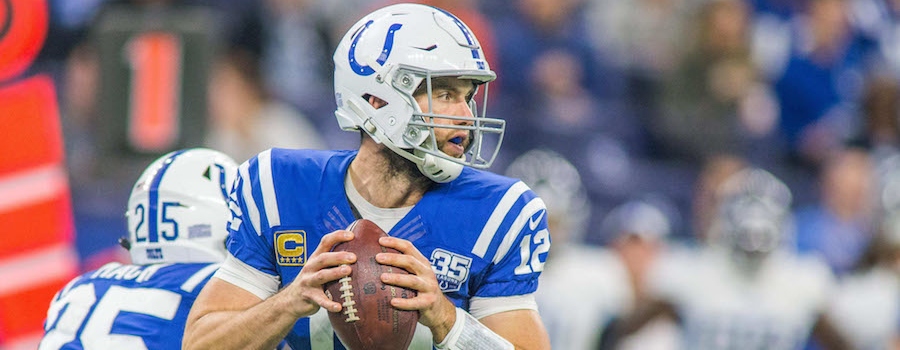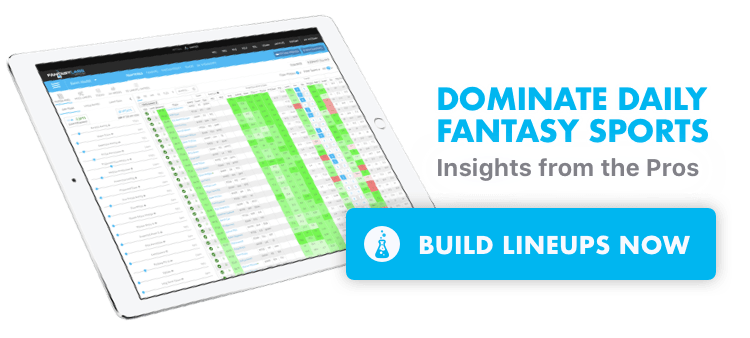In the weekly Fantasy Trends, we leverage the Trends tool to find quarterbacks, wide receivers and running backs with notable data points for the upcoming DFS main slate. For more of our weekly football content, visit our NFL homepage.
Four teams are faced with very unique scenarios this week. The Divisional Round is the only round of the playoffs when a team goes on the road to play another team that’s coming off a bye week.
This presents a similarly unique opportunity for DFS players. Do the home teams boast improved offensive performance following extended rest? Do away teams shrink in the moment, or rise to the challenge?
Sample Size and Data Treatment Issues
We definitely have some obstacles ahead of us if we intend to answer the above questions with a great degree of statistical certainty.
Firstly, and most importantly, we have a colossal sample size problem. Our FantasyLabs database only reports playoff results for the 2016-17 and 2017-18 postseasons. And since our focus is on Divisional Round games, that reduces our sample size to eight games. Even with immense statistical manipulation, that isn’t a big enough sample size to warrant strong results-based conclusions.
Secondly, it’s not like the home team’s first-round bye week is the only unique factor affecting fantasy performance. We have to factor in regular season vs. playoff splits, home vs. road splits, favorite vs. underdog splits and then attempt to isolate the effect of the bye.
But rather than concealing or ignoring these statistical problems, we’ll walk through them together. Consider this a case study in ethical and well-reasoned interpretation of results.
Feel free to TLDR; this by skimming until the “Final Conclusions” section, where you’ll find my target or fade recommendations. But if you’re a stats junkies like me, strap in. This one’s going to get kind of crazy.
Ethical Interpretation of Results
We never want to anchor too strongly to any one piece of data. Instead, we should strive to bring our multivariate conclusions into logical alignment based on a consistent and systematic argument. We also must be cautious not to be disingenuous to the results or to the real on-field situation. When forming a systematic line of reasoning, your conclusion should often — but not necessarily always — support your intuition.
Hopefully, my explanations for my logical conclusions at critical points in this analysis will help you in forming your own conclusions about similarly confusing or confounding data. While this article focuses on the postseason, the logic we use to interpret our results is equally valuable in all sorts of applications. For example, we experience similar sample size issues in the early regular season.
Leveraging Bet Labs
Okay, let’s begin.
Before we dive into our DFS analysis, let’s first take a trip over to Bet Labs to establish a baseline expectation for Divisional Round games. These results should help us in forming a grounded hypothesis for individual players’ fantasy performance.
Bet Labs Results:
Divisional Round Home Favorites have gone:
- 36-21-0 straight up (SU) for a 63.2% win-rate.
- 21-35-1 against the spread (ATS) for a 37.5% cover-rate.
The over in Divisional Round games has gone 33-26-1 (55.9%).
Alright, now let’s formulate a DFS hypothesis based on our Bet Labs results.
Our Current Hypothesis:
- If home teams often fail to cover the spread (37.5% cover rate),
- And if game totals trend toward the over (55.9% of the time),
- Then this implies that opponents are hitting their implied team totals at an elevated rate.
There are two possible ways that opponents could achieve this. The first option is that opponents simply perform better offensively in these games. If that is true, our FantasyLabs data should demonstrate it unequivocally in our analysis. The second option is that opponents perform about the same as you would expect, but Vegas is handicapping them too harshly. These possible causes are not necessarily exhaustive of all possibilities, but they are primary in importance to this analysis.
With this baseline in mind, let’s finally leverage our Trends Tool to see what’s going on.
Results: Home/Away Splits in Divisional Playoff Games
Well, that was unexpected. Home players are absolutely crushing it, road quarterbacks report a moderate decline in production and road running backs and wide receivers report Plus/Minus scores approaching zero.
So what the heck is happening here?
Our Bet Labs data pointed to improved production from road teams and stagnancy for home players. These fantasy results are almost exactly the opposite of what we would have expected from the Bet Labs data.
The most obvious explanation is sample size. Our Bet Labs database goes back to the 2003-04 season; our FantasyLabs postseason DFS data only goes back to 2016-17. That’s 13 seasons of DFS data missing from our results.
At this point, the most appropriate conclusion is likely to dismiss our playoff results due to sample size.
Nonetheless, these preliminary results do complement our findings from last week’s Trends-based analysis. In that article, we found that home/away and favorite/underdog splits widen dramatically during the playoffs. However, if we accept this generous interpretation of the results, then why aren’t home teams covering more often? And how are away teams hitting their implied team totals more often?
Addressing Our Playoffs Sample Size Problem
In order to evaluate the external validity of our FantasyLabs playoffs sample size, let’s alter our sample’s parameters to establish a wider net. To do this, we’ll examine regular-season games in which the home team is coming off a bye week and the away team played in the previous week. But in order to ensure our results are relatable to playoff-like conditions, let’s also ensure that both teams have records of at least .500 entering the matchup.
This second analysis attempts to control the regular season vs. playoffs variable. If our forthcoming regular-season results corroborate our previous Divisional Round results, then it’s likely that the bye week — not the playoff atmosphere — is our variable of interest. This would eliminate our sample size problem but instead raise questions about our betting results.
If, however, our results are substantially different from the Divisional Round report, then something else must be going on.
Results:
Now quarterbacks’ and wide receivers’ splits have completely flipped orientation. Away teams perform way better with a larger regular season sample. At running back, home players still boast a slight edge, but both groups report negative Plus/Minus scores. Nonetheless, the differences between home and away running backs are now very small — not drastic like we saw in our Divisional Round assessment.
These results fit our betting data much more nicely — and they utilize a large sample size to do so. So I’m inclined to judge these results as more valid than our Divisional Round analysis. Indeed, if we accept these regular season results, we must necessarily dismiss our postseason analysis on the basis of sample size alone. We could end the article right here with the conclusion that away quarterbacks and wide receivers are generally worth targeting against teams coming off a bye week — whether in the regular season, or in the playoffs.
But there’s an alternative interpretation to consider.
Because our data is so drastically different between the regular season and postseason, it could be the playoff environment that’s affecting our results. If we accept the idea that the postseason is fundamentally different from regular season play, then we can also logically accept that our results ought to be different in that playoff environment.
This line of reasoning would bring into logical accord our findings from last week that the playoffs exacerbate home/away splits. However, this interpretation of the results has a problem: Even if we accept this premise, our FantasyLabs postseason results still confound our Bet Labs results. We would still have no reasonable explanation for home teams’ poor historical cover-rate or for the Divisional Round trend towards the over. This interpretation also does not explain how away teams hit their implied team totals more often in such contests.
Now, we are at yet another crossroads. One of our options is to reject last week’s findings. I personally don’t like this option, because last week’s sample was much larger, and our methods were strong. Nonetheless, rejecting all of our playoff results — including last week’s piece — would be a perfectly reasonable conclusion.
Our second option is to reject that the bye week matters at all. Instead, we could posit that the primary mitigating factor here is playoff sample size — not the bye week.
Re-Considering the Effect of Bye Weeks
In order to re-frame our conversation on bye weeks, let’s examine the regular season in isolation — much like we did to address our playoff sample size problem. We’ll look at how home and away teams perform when the home team is coming off of a bye week versus a game week. We’ll also be excluding games played on short rest (aka Thursday games), since that’s a separate issue entirely and is also not generalizable to the playoff setting.
Results: Home Team Coming Off Bye Week
Results: Home Team Coming Off A Game
Home quarterbacks coming off of a regular season bye week boast minor improvements statistically — a far cry from the massive +4.95 Plus/Minus result we found during the Divisional Round of the playoffs. For contrast, away quarterbacks playing against teams coming off of a regular season bye week boast substantially elevated statistics across the board.
Wide receiver results generally match quarterback results in orientation, but the splits are incredibly narrow. In fact, the effect size appears almost non-existent for both home receivers and away receivers. Interestingly, home running backs report a substantial decline in performance when coming off of a bye week. Away running backs seem to partially pick up their slack in those games, but the effect is not particularly pronounced.
The big takeaway from these results is that the bye week might not matter as much as we assumed initially. Sure, home teams do benefit some from the additional rest (except for running backs for some reason). But the bigger discovery is that away teams facing teams coming off of a bye also improve markedly. This statistical improvement could be due to momentum or familiarity; or instead, it could also imply that the opposing home defense has to shake off some bye week rust.
>> Sign up for The Action Network’s daily newsletter to get the smartest conversation delivered into your inbox each afternoon.
Final Conclusions
It’s been a long, tangent-filled road, but all of our research is finally starting to coalesce into a cohesive, logical argument. If we bring together all the pieces in our analysis, we’re left with two big conclusions:
- Bye week rest does not dramatically or unequivocally improve a home team’s offensive performance. As a result, our initial Divisional Round analysis is largely invalid due to its flawed premise.
- There is cause for questioning the validity of last week’s NFL Trends article. In fairness, we found no absolute evidence to disprove that home/road splits widen during the playoffs. However, we established new, confounding evidence from Bet Labs and the regular season that suggests that away teams might at least be resilient to that trend during the Divisional Round specifically. Away teams historically boast improved production against teams coming off a bye week, which characterizes every home team during the Divisional Round.
Target and Fade Recommendations for DFS
Quarterback
Our conclusions do not suggest that any particular quarterback deserves strong fade- or target-consideration this week. Nonetheless, in a previous week’s trend on high total games, we found value in pivoting to underdog quarterbacks in games with an opening Vegas total of 50 or higher and an implied opposing team total of 26.5 or higher.
The Colts at Chargers game currently fits that trend.

Credit: Trevor Ruszkowski-USA TODAY Sports. Pictured: Andrew Luck
Consider Targeting:
- Andrew Luck, Colts: $6,200 DraftKings
In a previous week’s trend on below-freezing temperatures, we found that quarterbacks’ Plus/Minus falls to -1.84 when the game-time temperature is below 32 degrees. The Chargers at Patriots game currently fits that trend.
Consider Fading:
- Philip Rivers, Chargers: $5,700 DraftKings
- Tom Brady, Patriots: $5,600 DraftKings
Running Back
Our analysis casts a shadow of doubt regarding home running backs coming off a bye week. These players historically report a 1.36-point decrease in average actual points, a Plus/Minus of -0.74 relative to their salary-based expected production and only 36.4% consistency. This negative trend applies to the Patriots, Chiefs, Rams and Saints.
I am by no means advocating that you outright fade players like Todd Gurley ($8,200 DraftKings) or Alvin Kamara ($7,300 DraftKings) based solely on this finding. However, pivoting to a road running back like Melvin Gordon ($6,200 DraftKings) of the Chargers could make sense. Historically, running backs have performed better in below-freezing temperatures and/or windy conditions, both of which characterize the Gordon’s game against the Patriots in New England. Moreover, by rostering Gordon, you avoid stacking two home running backs — thereby reducing your exposure to negative Plus/Minus risk.
Wide Receiver
Our conclusions do not suggest that any particular wide receiver deserves strong fade- or target-consideration this week. However, in a previous week’s trend on targeting wide receivers in late-season DFS, we found that Consistency, Duds and Upside percentiles can be used to identify under-priced receivers. The following players fit all positive splits in that trend.
Consider Targeting:
- Julian Edelman, Patriots: $6,300 DraftKings
- Robert Woods, Rams: $5,900 DraftKings
- Chris Conley, Chiefs: $3,900 DraftKings
- Cordarrelle Patterson, Patriots: $3,500 DraftKings
News Updates
After this piece is published, FantasyLabs is likely to provide news updates on a number of players mentioned here. Be sure to stay ahead of your competition with our NFL news feed.
Photo Credit: Derick E. Hingle-USA TODAY Sports
Pictured Above: Drew Brees







